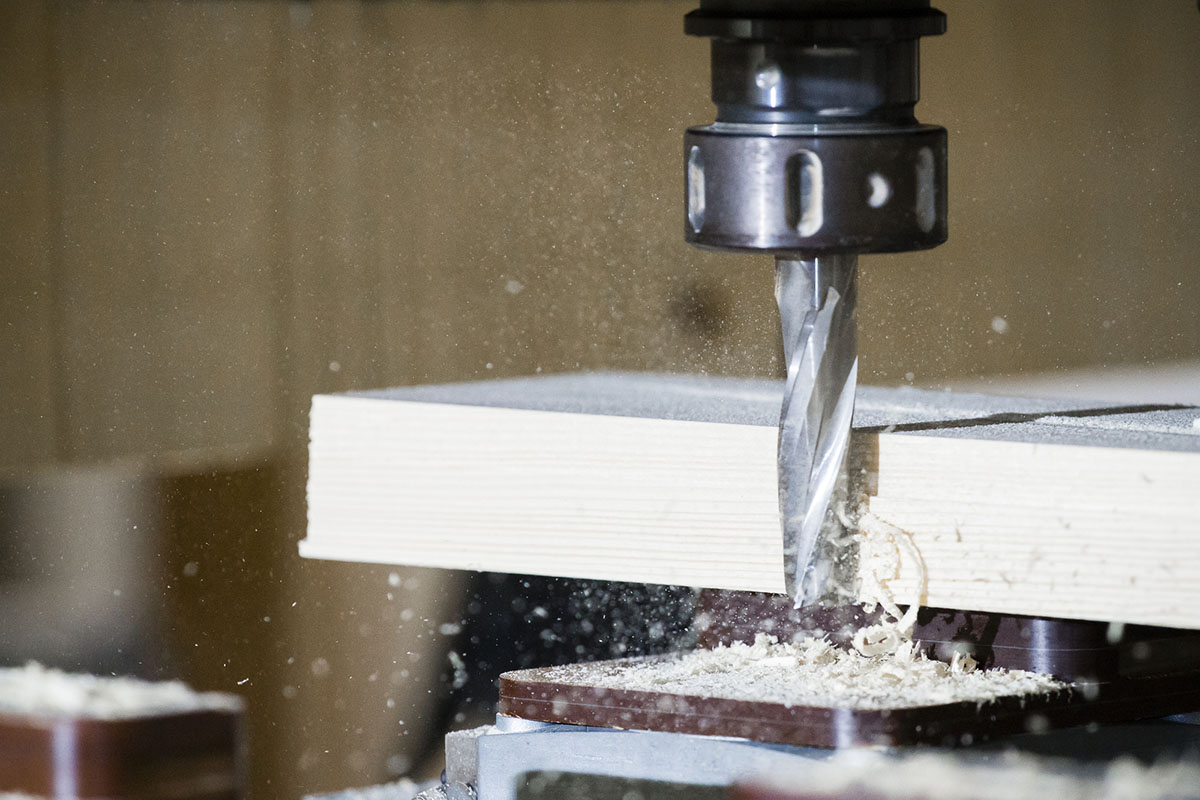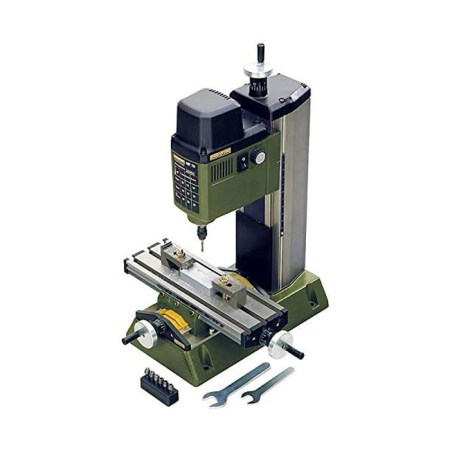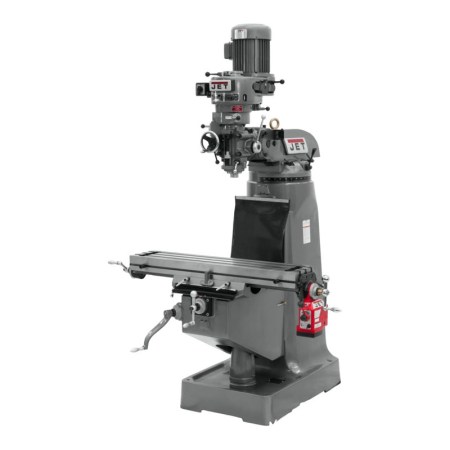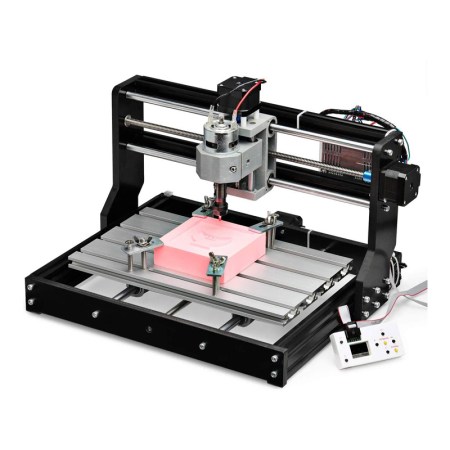
We may earn revenue from the products available on this page and participate in affiliate programs. Learn More ›
During the milling process, metal, wood, or plastic is fed through a rotating, multipoint cutter on a table that moves to the left and right as well as forward and backward. The milling cutter can be raised or lowered to adjust the depth of the cut, similar to the vertical movement of a drill press. The tool’s three axes of control allow for precision cutting over the entire surface of the material.
Milling machines can be used for a variety of purposes, including machining flat and contoured surfaces, creating external and internal threads, and cutting gears and slots. When looking for a milling machine, consider key factors, such as the size and cutting capacity, that your projects require. Below find a list of some top options and details about milling machine features to help you find the best option for your workshop.
- BEST OVERALL: Proxxon MICRO Mill MF 70
- RUNNER-UP: JET JMD-15 Milling/Drilling Machine
- BEST FULL SIZE: Jet JTM-2 115/230-Volt Vertical Milling Machine
- BEST CNC: Genmitsu CNC 3018-PRO Router Kit GRBL Control

What to Consider When Choosing the Best Milling Machine
Before choosing the best milling machine for a garage or workshop, keep in mind several important product features, including the type of milling machine, size, cutting capacity, spindle depth, table travel, and the stability of the worktable.
Type
The two main types of milling machines operate with a vertically oriented cutting tool or a horizontally oriented cutting tool.
- Vertical milling machines have a cutting tool mounted on a vertical spindle that can be raised or lowered. This type of milling machine can drill or cut deeply into material, but it isn’t a good choice for machining flat or contoured surfaces.
- Horizontal milling machines use a horizontally oriented cutting tool that can machine the surface of materials. This style of milling machine isn’t for drilling, boring, or producing slots—the broad cutting tool can’t make narrow, penetrating cuts.
Size
The three main sizes of milling machines are micro, benchtop, and full size. Consider the space available in the workshop when selecting size.
- Micro milling machines, a smaller version of a benchtop milling machine, typically have a vertical cutting tool. While usually measuring about 6 by 9 inches, they should still be used on a flat surface like a workbench. Use a micro milling machine to machine small, detailed patterns, cut threads, and bore or drill through wood, plastic, and thin metals.
- Benchtop milling machines, with an overall footprint of about 1 by 2 feet, have a larger worktable than micro milling machines. Made for working with more robust metals and with either a vertical or horizontal cutting tool, benchtop milling machines can be used for a variety of projects.
- Full-size milling machines are significantly more expensive than either micro or benchtop products, and they’re usually found only in professional machining shops. These milling machines stand on the floor of the workshop and can be more than 6 feet tall. They’re used primarily for working with thick metals, such as steel, titanium, and aluminum.
Cutting Capacity
On a milling machine, cutting capacity refers to the overall table size and cutting dimensions. Capacity depends on several factors, including table travel, quill travel, and spindle gap.
- The table size determines the amount of material that safely can be worked. If the material extends off the edges of the table, the material can flex with the cantilevered weight, causing the machine to create unintended angled cuts. Always ensure the table is sized so the entire piece of material is supported. Table sizes range from as small as 3 by 6 inches to 1 by 4 feet.
- Table travel refers to the distance the table can move left, right, backward, or forward with the handwheel controls. When the table has a small travel distance, some parts of the material may not be placed under the milling cutter. A large table travel ability makes it easier to accurately position the material and move it through the milling cutter.
- Quill travel is the distance the quill, a part of the spindle used to machine difficult-to-reach areas on the W-axis, must extend from the machine.
- Spindle travel is used to measure the depth of the cut for milling machines. With a short spindle travel, the cutting tool will experience difficulties in cutting completely through thick materials. This distance also is referred to as the “Z-axis travel.”
For the best cutting capacity, look for a milling machine with a table size capable of supporting the material. Also, investing in a tool with large table travel and quill or spindle travel helps ensure the project isn’t limited by the tool.
Stability
In a milling machine, stability is very important. If the material isn’t stable during the cutting process, machining gears and threads or resurfacing likely will be clumsy and inaccurate. Look for a milling machine with a broad, heavy base, like cast iron, that won’t shift or vibrate while the machine is in use.
For additional stability, consider a milling machine with built-in T-slots, which enable the user to secure the material to the table. A computer numerical control (CNC) milling machine is a good idea for those who plan to complete many projects. Instead of manual adjustments, the machine moves automatically via commands from a computer.
Our Top Picks
These top picks were chosen based on quality, price, customer satisfaction, and the considerations mentioned above. Read this list to learn about some of the best milling machines for your metalworking projects.
Best Overall
Proxxon MICRO Mill MF 70
The Proxxon micro milling machine has a quiet, vibration-free operation designed for opticians, jewelers, and hobbyists for precise, clean cuts in delicate materials. This milling machine has a broad, cast iron base that should be positioned on a flat, firm table or workbench to ensure the machine remains stable while the spindle is rotating at speeds between 5,000 and 20,000 RPM.
The cutting capacity of this milling machine includes an X-axis travel of 5.3 inches, a Y-axis travel of 1.8 inches, and a Z-axis travel of 2.8 inches, for a total work area of 26.7 cubic inches. The table measures 8 inches by 3 inches and has three T-slots to secure material as it’s cut or drilled.
Runner-Up
JET JMD-15 Milling/Drilling Machine
The 1-HP motor on the JET JMD-15 provides enough energy to run the spindle at 12 different speed settings, from 110 to 2,580 RPM. A cast iron column and base help keep the milling machine steady and reduce vibrations while the machine is in use. Place it on a flat table or workbench. The head of the milling machine has a versatile 360-degree swivel for more precise cutting, drilling, and machining.
This benchtop milling machine features large hand wheels that are easy to operate and a broad worktable. The cutting capacity of the milling machine is determined by the X-axis travel of 14 inches, the Y-axis travel of 5.5 inches, and the Z-axis travel of 3.5 inches. The milling machine comes with an adjustable work lamp to illuminate the material in dim lighting conditions and a spindle guard to help protect the user from flying bits of metal, wood, and other debris.
Best Full Size
Jet JTM-2 115/230-Volt Vertical Milling Machine
Outfit a maintenance, repair, or machine shop with this full-size milling machine from Jet that stands more than 6 feet tall. It has an X-axis power feed installed for an accurate feed rate of material, making it easier to create duplicate cuts in multiple pieces of metal. The milling machine weighs more than 2,000 pounds, and it has a firm base that won’t shift or vibrate during use.
The 2-HP motor produces spindle speeds from 80 RPM to 2,720 RPM, and a heavy-duty spindle brake quickly brings the tool to a stop when work is finished. The worktable measures 9 by 42 inches and has an X-axis travel of 23.9 inches, a Y-axis travel of 12.5 inches, and a Z-axis travel of 5 inches. The milling machine’s worktable also comes with three 2.5-inch T-slots for added stability.
Best CNC
Genmitsu CNC 3018-PRO Router Kit GRBL Control
The Genmitsu CNC milling machine operates according to commands that can be input through Arduino and GRBL software. Support, training, and additional tutorials to learn how to use the specific software are available online. While the milling machine is more accurate when it’s connected to a computer, it can be used with a remote control so it isn’t tethered to one location.
This milling machine has a total working area of 150.8 inches cubed. It measures 11.8 inches along the X-axis, 7.1 inches along the Y-axis, and it has a Z-axis range of 1.8 inches. Use it with plastics, wood, acrylics, PVCs, PCBs, and soft metals like aluminum.
FAQs About Milling Machines
Now that you know more about milling machines, you may have additional questions. Keep reading to find the answers to some of the most commonly asked questions about milling machines and how they work.
Q. How does a milling machine work?
A milling machine works to cut through hard metals with a milling cutter that can be raised or lowered with the Z-axis hand wheel. The machine also uses a moveable platform to hold the material in place. This platform can typically move left or right and backward or forward using the Y-axis hand wheel and the X-axis hand wheel for control. With three axes of control, the machine can move the material through the milling cutter for precise, stable cuts.
Q. Are Bridgeport mills still made?
Yes, Bridgeport mills are still being made, but they are now manufactured by Hardinge Inc.
Q. Do I need cutting fluid when I’m milling?
Cutting fluid is usually not necessary for milling, though it should be used to lubricate, cool, and flush away dust when working with cast iron, finishing stainless steel or aluminum, or milling other heat-resistant alloys at low cutting speeds.






